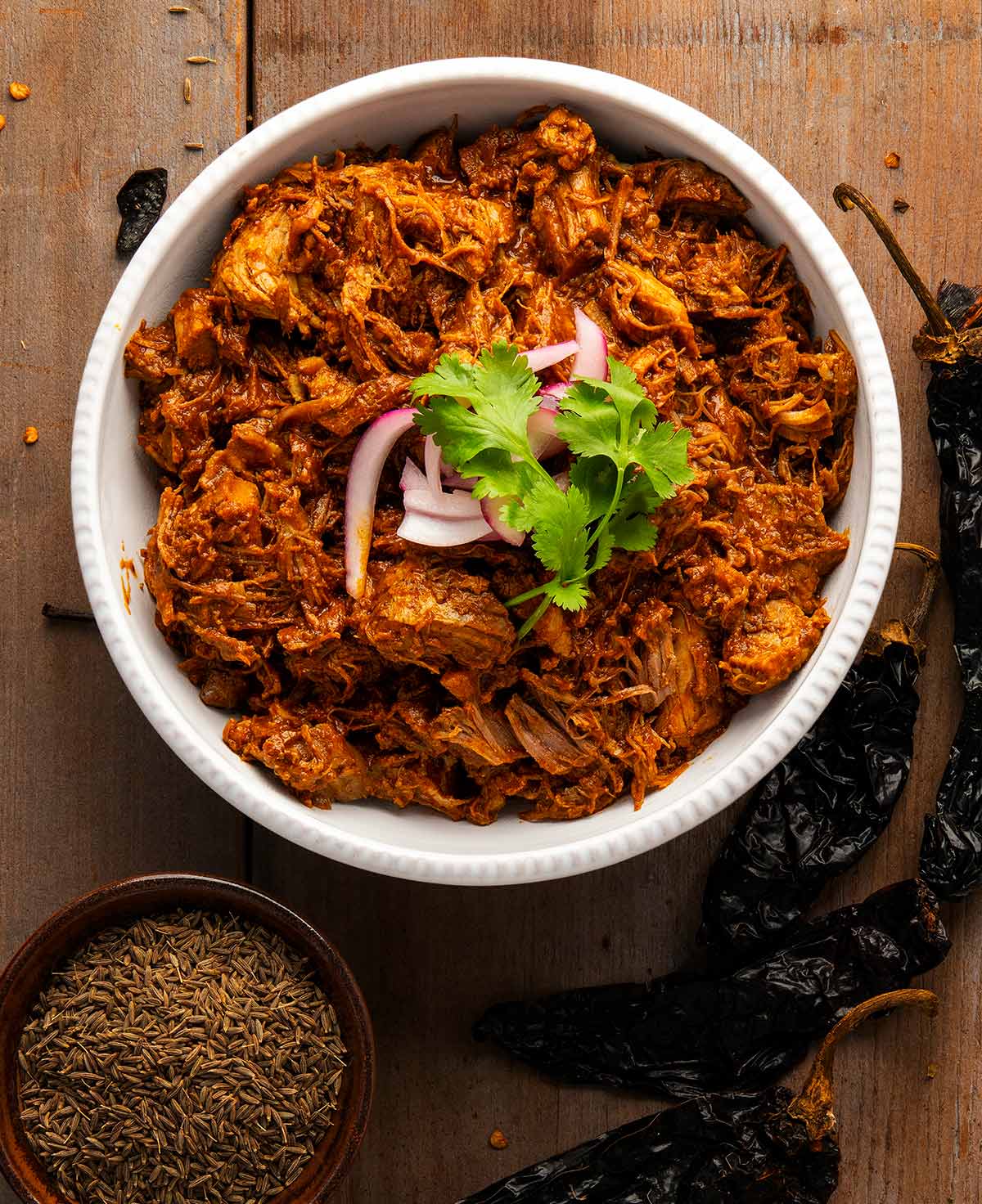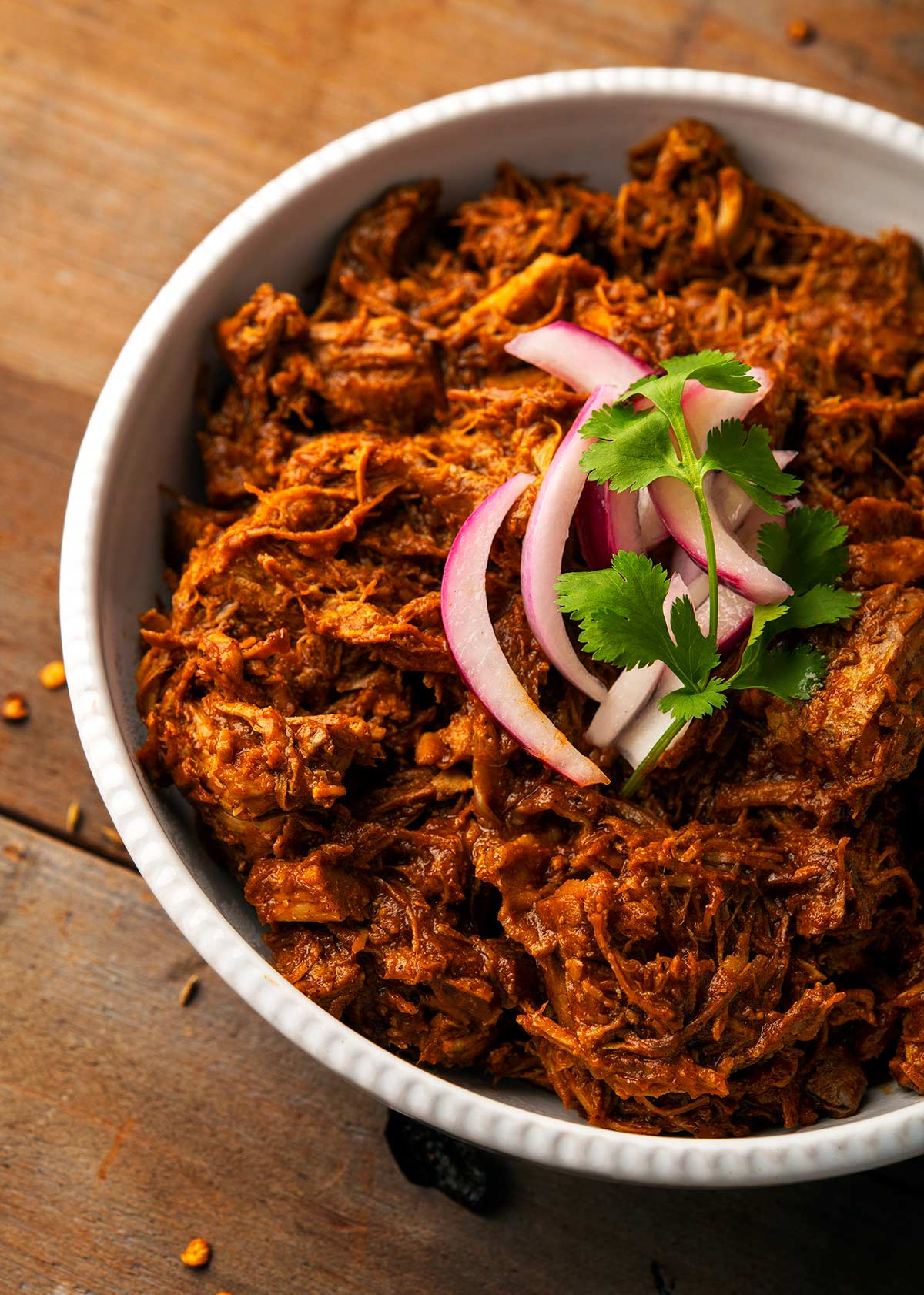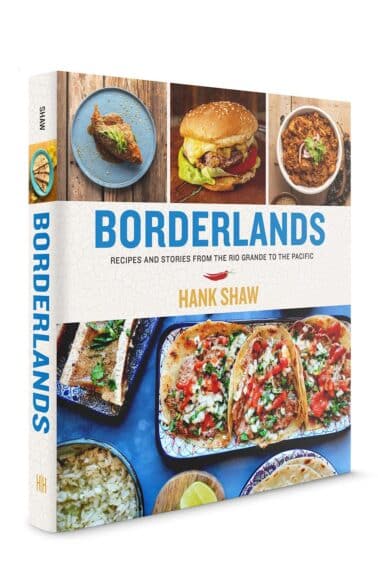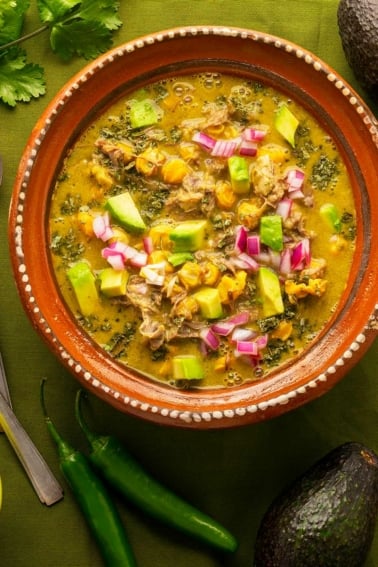Chilorio, Sinaloa-Style Braised Pork
January 17, 2022 | Updated May 24, 2025
As an Amazon Associate I earn from qualifying purchases.
Sadly, most Americans know the Mexican state of Sinaloa only for the drug cartels. But there is so, so much more to the place, notably the food. Chilorio, braised, shredded pork, is easy to make and so versatile you’ll want to learn how to make it.

I first ate chilorio back in the late 1990s, when Holly made some for me. At the time, my knowledge of Mexican food wasn’t great, but I loved that it was tangy and flavorful without blowing my head off with chiles — and how great it was as leftovers.
Since then, I’ve only eaten chilorio in Baja California; I’ve not yet been to Sinaloa. But since Baja Sur and Sinaloa are “connected” by a popular ferry service across the Sea of Cortez, many Sinaloan specialties have taken root in Baja, notably shrimp tacos gobernador.
The soul of chilorio is the combination of chiles, cumin and something acidic, usually vinegar. This sets it apart from a similar dish from Sonora, carne con chile, which has a less acidic salsa and is usually served with a red meat in larger pieces.
I’d like to say it’s always pork, but I’ve seen chicken versions, too. We used some wild hog shoulder here. Pork, wild or farmed, javelina, chicken, pheasant, chukars, grouse, or rabbits would all work.
Chilorio is always shredded, because it is intended to be used in tacos, burritos, tortas (Mexican sandwiches), or alongside rice and beans. I’ve seen it served in sopes, too; sopes are little corn masa boats filled with good things. And I imagine it would be fantastic in empanadas.

You make chilorio by simmering the meat with some onion, bay leaves and maybe some peppercorns and garlic cloves.
Either you simmer it in just enough water so that it will boil away and the meat sears in the fat that has rendered, or, you can do what I do, which is simmer until tender, then put in a pan with lard and sear that way.
I do this because wild pork takes a lot longer to get tender, and has little fat. Either way, you will want a good amount of lard to sear the meat and cook the salsa with.
The salsa is pretty standard: Char onions and garlic, and toast the cumin and dried chiles if you want to, put it all in a blender with Mexican oregano, water and salt and puree.
That goes into the searing meat and gets cooked by the lard, and, after a bit, you smash it all together to get a pan of shredded amazingness.
Once made, chilorio keeps for a few days in the fridge, and reheats well. If you’re looking for more braised pork recipes, check out asado de puerco, an intriguing dish out of northern Mexico.
Chilorio, Sinaloan Braised Pork
Ingredients
- 2 to 3 pounds pork shoulder
- 1 large white onion, sliced in quarters
- 8 cloves garlic, unpeeled
- 2 to 5 bay leaves
- Salt and black pepper
- 4 guajillo chiles
- 4 pasilla or ancho chiles
- 4 chipotle chiles
- 1 tablespoon cumin seeds, or 2 teaspoons ground
- 2 teaspoons coriander seeds, or 1 teaspoon ground
- 1 tablespon oregano, Mexican if possible
- 1/2 cup apple cider vinegar, or more to taste
- 1/3 cup lard
Instructions
- Cut the pork into large chunks about 3 inches across. Put them into a large, lidded pot and cover with water by 1 inch. Bring to a boil and skim any froth off. Lower the heat to a simmer and add 1/4 of the onion, 2 garlic cloves and the bay leaves. Salt to taste and cook until the pork is tender.
- Remove the seeds and stems of all the chiles. It's OK if a few seeds get stuck.
- Meanwhile, make the salsa. Heat a comal or griddle or heavy frying pan over high heat and char the rest of the onion and the garlic cloves.
- While the vegetables are charring, bring a medium pot of water to a boil. While that is heating, quickly toast the chiles on the hot comal — about 30 seconds total, flipping a couple times. You want the dried chiles to blister a little, but not blacken. When they are toasted and the pot of water hits a boil, put the chiles in the water and turn off the heat.
- If you want, toast the cumin and coriander seeds in a hot, dry pan until they smell nice. Put them in a spice grinder or a blender and grind. This step does add a lot of flavor.
- When the onions and garlic are nicely charred and the chiles soft, put them in a blender with the oregano and spices, salt, vinegar and enough water to make a sauce with the consistency of cream. Puree.
- Once the pork is tender, drain the broth and discard it or use in another recipe. Wipe out the pot and add the lard. When it's hot, add the chunks of pork and sear hard on one side — you want a combination of crispy and soft.
- When you have achieved that, pour in the salsa and mix well. Turn the heat to a simmer and cook for 10 to 20 minutes, then serve.
Notes
Keys to Success
- Pork shoulder is preferred, but really any cut of pork will work. And as I mentioned, you can use chicken thighs, upland game birds, rabbits or even venison if you wanted to.
- The chile mix determines the heat level. Skip the chipotles if you want to keep it mild, and for a redder sauce, use only guajillos, or New Mexican red chiles or California chiles, which are dried red Anaheims.
- If you hate vinegar, use lots of lime juice.
- Hate lard? Use some other oil.
- Once made, you can keep this for a week in the fridge, and it freezes well.
Nutrition
Nutrition information is automatically calculated, so should only be used as an approximation.






Hey Hank, I enjoy the blog! You mentioned having Chilorio in Baja. Would you happen to know of any places to get it in Tijuana, which is closer to my neck of the woods? I am not fully equipped with a reliable stove in my current living situation, so I’ll have to wait to try making it myself!
Dan: Nope, I don’t know a spot in Tijuana. The best I’ve had was between Cabo and Todos Santos.
Family said it was a keeper. Some notes –
1. I thought it was weird to keep the skins on the garlic cloves. When it gets blended to smithereens, nobody cares
2. Suggest 2 tsp salt in the water with the pork, 1 tsp salt blended into salsa. Then people can add salt as they wish
3. I needed 4-5 c water to make the salsa the consistency of cream
4. I couldn’t find dried chipotle’s anywhere but I did find Morita peppers which are basically the same but less smoky
5. Do not leave the food feed-hole open in your Vitamix when dropping in splices for blending. Coriander seeds will fly all over your kitchen. Do not ask me how I know this.
I smoked a pork butt Sunday and used leftover for this dish, I should have used all the meat instead of leftover. We did not have Mexican oregano so I used dried McCormick which is what we had on hand, limes juice with the AS vinegar, man is it good on tortillas. we were out of chipotle but the smoked meat was plenty, on my taco rotation from this day forward!
I live in New Zealand so procuring those chiles is very difficult. I grow my own jalapeños and cayenne type chiles. Will I lose much by substituting?
Bram: Yes, unfortunately. The chiles you use in this recipe are very different from cayenne and jalapenos.
https://www.mexifoods.co.nz/dried bro
Made this with the front legs & backstraps from a massive white-tailed jackrabbit. Fantastic recipe and method, we loved it! And I’ve been using your recipes for corn & flour tortillas for a couple years, finally have those totally dialed in. Thanks for all your recipes and writing!
I made this today on a “cold” Houston day with some wild hog we trapped in October. It was delicious. This will definitely be going into our rotation. I’m looking forward to converting into a breakfast dish with some fried eggs on it. Winner winner piggy dinner.
Hank,
Looks delicious!
I think I will actually try it today.
Have a great week!
Tad
This recipe looks great. However I’m on keto. Where are all the carbs coming from?
Frank: I’ll be honest. I have no idea. We use an auto calculator for nutrition info, and sometimes it’s a little wacky.
I have made this several times. It tastes almost exactly like the dishes we made in Mexico. Nicely done Mr. Shaw. And Holly – thank you for making this dish for him!